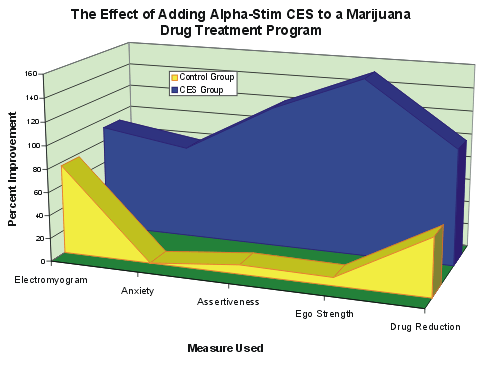Overcash, Stephen J, and Siebenthall, Alan. The effects of cranial electrotherapy stimulation and multisensory cognitive therapy on the personality and anxiety levels of substance abuse patients. American Journal of Electromedicine, 6(2):105-111, 1989.
32 marijuana users with various psychophysiological stress disorders, diagnosed with generalized anxiety disorder and substance abuse disorder, were referred from family practitioners and randomly assigned to a control group (N = 16) in which they were treated with biofeedback electromyogram (EMG) training, Quieting Response (QR) relaxation tapes and psychotherapy, or a CES experimental group (N = 16) which was treated with biofeedback EMG training, QR, psychotherapy, plus multisensory emotional therapy using the Relax and Learn System and Alpha-Stim CES. There were significant differences in the outcomes of the two groups. Although little change was recorded in EMG readings through the second treatment, by the fifth treatment the improvement was remarkable. The experimental group was able to reduce their mean EMG from 38 to 3.2 ÁV. The control group also reduced their mean EMG from 41 to 9.6 ÁV. Analysis of variance (F = 5.43, P<.01) indicate significant differences between the groups. The experimental group averaged the same amount of relaxation at the end of 8 sessions that the control group reached in 10. In the 16PF personality test, there were significant differences between groups in 4 areas. Nervous tension was reduced in both groups. The experimental group was significantly more planful (4.0 pretest to 7.2 post test, P<.01) in the self sufficiency test, a good indicator of reduction in anxiety levels, whereas there was no change in the control group (4.6 to 4.6). In area of dominance, a measure of assertiveness, the experimental group had a significant gain from 3.2 to 7.1, while the control group had an insignificant gain of 4.0 to 4.3. Ego strength for the experimental group rose from 3.0 to 7.6 which represents a significant (F = 6.95, P<.01) increase in decision making skills, while the control group had an insignificant gain (F = .28, P>.75) from 2.8 to 3.0. The experimental group was also able to reduce their use of marijuana more quickly testing drug free in only 6 weeks, and sustained over a longer period of time than the control group which was drug free in 9 weeks. No side effects were reported.
|
